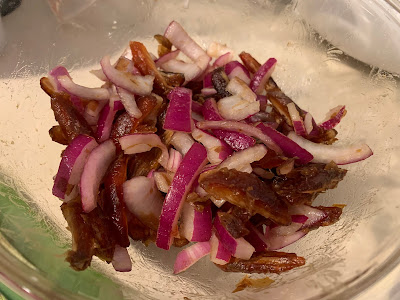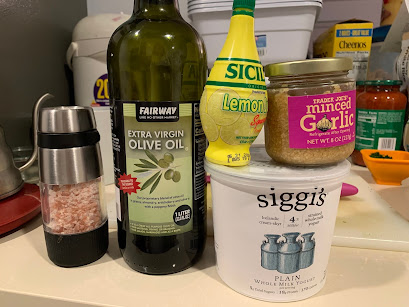The Week 34 challenge came up as figs, which weren't the easiest thing for us to get in a pandemic, so I considered skipping it. Since I'm not a huge fan of mixing fruit into savory dishes, if I did get figs, I was just going to want to make Ottolenghi's roasted sweet potatoes and figs again, which I already did for a challenge in 2017. A couple of people on Reddit mentioned their difficulty in getting figs, and it was suggested that perhaps they use something like dates, since those are often interchangeable with figs in recipes. Considering the next recipe in Ottolenghi's Jerusalem used dates, that seemed like a logical place to go.
The third recipe in the book was for a baby spinach salad with dates and almonds. Although I didn't love that I would need to mix fruit with savory again, after how well the first recipe in the book turned out (the sweet potatoes with figs), I trusted Ottolenghi on this one. Other than not measuring everything, I tried to stick closely to the recipe, hoping it would come out as intended.
The ingredients for our version of the salad were:
- 1/2 red onion ($0.50)
- 2-3 handfuls of Medjool dates ($1.66)
- about 1 tbsp white wine vinegar ($0.07)
- salt ($0.02)
- 2 tbsp butter ($0.18)
- about 2 tbsp olive oil, divided ($0.20)
- 1.5 whole wheat pitas (about 3.75 oz) ($1.39)
- 1/2 cup whole roasted and unsalted almonds ($1)
- a couple tsp sumac ($0.15)
- a few shakes of red pepper flakes ($0.02)
- 1 bag of baby spinach ($2.29)
- juice of 1 lemon ($0.39)
The salad cost about $7.87, which was less expensive than almost any lunch we would get if we dined out. Sounded good to us!
I thought this salad was relatively straightforward in terms of prep and that it wouldn't take more than half an hour, even at my glacial speed. The one thing I didn't account for, however, was that I'd never worked with Medjool dates before. I'd had dates, but never made them at home, so I had a lot of questions. Did they need to be washed? Did I need to peel the skins off? How would I know if they were fresh (even though we just bought them two days earlier)? The problem was, having never had one whole before, I didn't even know the questions to ask in advance, so I had to keep pausing to look things up, and as a result, prepping took far longer than it should have.
The steps for making the salad were:
1. Prep (part 1) - thinly slice the onion, remove the pits from the dates, and quarter the dates lengthwise.
2. In a small bowl, combine the white wine vinegar, onion, dates, and a pinch of salt. Mix with your hands, and marinate for about 20 minutes. [The instructions said to drain the residual vinegar here and discard, but we didn't have any.]
3. Prep (part 2) - coarsely chop almonds, and tear pita into pieces about 1.5 inches in width.
4. In a medium skillet, heat the butter with about 1 tbsp of olive oil over medium heat. Add pita and almonds, and stir continuously for about 5 minutes until the pita is crunchy and golden (or in our case, browned since we used whole wheat pita).
5. Remove skillet from heat, and add the sumac, red pepper flakes, and a pinch of salt. Allow to cool a bit. [We didn't have that much time, since my Medjool dates research took so long, but at least allowed it to cool enough to be touched without burning my hands.]
6. In a large bowl, add the spinach, pita and almond mixture, date and onion mixture, another tbsp of olive oil, and the lemon juice. Mix well. [I needed to use my hands because nothing else was working.] Season to taste if needed. [Nothing needed to be added here.]
This salad turned out really well! It was far more filling than I thought it would be before making it, but it did have a lot of pita and almonds in it, in addition to the dates. The sweet dates worked well with the rest of the salad, and it still made for a good savory salad. Although not our favorite salad, we would make this again.
Jerusalem Cookbook Project Rankings:
2. Baby spinach salad with dates and almonds















